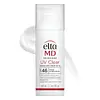What's inside
What's inside
 Key Ingredients
Key Ingredients

 Benefits
Benefits

 Concerns
Concerns

 Ingredients Side-by-side
Ingredients Side-by-side

Zinc Oxide 9%
Cosmetic ColorantEthylhexyl Methoxycinnamate 7.5%
UV AbsorberWater
Skin ConditioningCyclopentasiloxane
EmollientNiacinamide
SmoothingOctyldodecyl Neopentanoate
EmollientHydroxyethyl Acrylate/Sodium Acryloyldimethyl Taurate Copolymer
Emulsion StabilisingButylene Glycol
HumectantPhenoxyethanol
PreservativePolyisobutene
Triethoxycaprylylsilane
Tocopheryl Acetate
AntioxidantPEG-7 Trimethylolpropane Coconut Ether
EmulsifyingOleth-3 Phosphate
Iodopropynyl Butylcarbamate
PreservativeLactic Acid
BufferingSodium Hyaluronate
HumectantPhosphoric Acid
BufferingZinc Oxide 9%, Ethylhexyl Methoxycinnamate 7.5%, Water, Cyclopentasiloxane, Niacinamide, Octyldodecyl Neopentanoate, Hydroxyethyl Acrylate/Sodium Acryloyldimethyl Taurate Copolymer, Butylene Glycol, Phenoxyethanol, Polyisobutene, Triethoxycaprylylsilane, Tocopheryl Acetate, PEG-7 Trimethylolpropane Coconut Ether, Oleth-3 Phosphate, Iodopropynyl Butylcarbamate, Lactic Acid, Sodium Hyaluronate, Phosphoric Acid
Water
Skin ConditioningDimethicone
EmollientAlcohol
AntimicrobialDiisopropyl Sebacate
EmollientOctocrylene
UV AbsorberEthylhexyl Salicylate
UV AbsorberPEG/PPG-9/2 Dimethyl Ether
Skin ConditioningSilica
AbrasiveTitanium Dioxide
Cosmetic ColorantTriethylhexanoin
MaskingIsopropyl Myristate
EmollientCetyl PEG/PPG-10/1 Dimethicone
EmulsifyingCetyl Ethylhexanoate
EmollientLauryl PEG-9 Polydimethylsiloxyethyl Dimethicone
Skin ConditioningButyl Methoxydibenzoylmethane
UV AbsorberDisteardimonium Hectorite
StabilisingButylene Glycol
HumectantGlycerin
HumectantHydrogenated Polydecene
EmollientDextrin Palmitate
EmulsifyingTrimethylsiloxysilicate
EmollientPEG-10 Hydrogenated Castor Oil
EmollientIsododecane
EmollientSorbitan Sesquiisostearate
EmulsifyingBis-Ethylhexyloxyphenol Methoxyphenyl Triazine
Skin ConditioningDiethylamino Hydroxybenzoyl Hexyl Benzoate
UV FilterDipotassium Glycyrrhizate
HumectantPEG/PPG-14/7 Dimethyl Ether
Skin ConditioningAminoethanesulfinic Acid
AntioxidantSaxifraga Sarmentosa Extract
Skin ConditioningCamellia Sinensis Leaf Extract
AntimicrobialCarthamus Tinctorius Flower Extract
Skin ConditioningEucheuma Serra/Grateloupia Sparsa/Saccharina Angustata/Ulva Linza/Undaria Pinnatifida Extract
EmollientSodium Hyaluronate
HumectantSophora Angustifolia Root Extract
Skin ConditioningSaccharina Angustata/Undaria Pinnatifida Extract
EmollientPPG-17
Skin ConditioningHydrated Silica
AbrasivePEG-10 Dimethicone
Skin ConditioningDisodium EDTA
Hydrogen Dimethicone
BHT
AntioxidantLimonene
PerfumingLinalool
PerfumingStearic Acid
CleansingBis-Butyldimethicone Polyglyceryl-3
CleansingPolyglyceryl-6 Polyricinoleate
EmulsifyingPEG-6
HumectantCitronellol
PerfumingHexyl Cinnamal
PerfumingCitral
PerfumingSodium Metabisulfite
AntioxidantGeraniol
PerfumingSyzygium Jambos Leaf Extract
Skin ConditioningTocopherol
AntioxidantPhenoxyethanol
PreservativeParfum
MaskingWater, Dimethicone, Alcohol, Diisopropyl Sebacate, Octocrylene, Ethylhexyl Salicylate, PEG/PPG-9/2 Dimethyl Ether, Silica, Titanium Dioxide, Triethylhexanoin, Isopropyl Myristate, Cetyl PEG/PPG-10/1 Dimethicone, Cetyl Ethylhexanoate, Lauryl PEG-9 Polydimethylsiloxyethyl Dimethicone, Butyl Methoxydibenzoylmethane, Disteardimonium Hectorite, Butylene Glycol, Glycerin, Hydrogenated Polydecene, Dextrin Palmitate, Trimethylsiloxysilicate, PEG-10 Hydrogenated Castor Oil, Isododecane, Sorbitan Sesquiisostearate, Bis-Ethylhexyloxyphenol Methoxyphenyl Triazine, Diethylamino Hydroxybenzoyl Hexyl Benzoate, Dipotassium Glycyrrhizate, PEG/PPG-14/7 Dimethyl Ether, Aminoethanesulfinic Acid, Saxifraga Sarmentosa Extract, Camellia Sinensis Leaf Extract, Carthamus Tinctorius Flower Extract, Eucheuma Serra/Grateloupia Sparsa/Saccharina Angustata/Ulva Linza/Undaria Pinnatifida Extract, Sodium Hyaluronate, Sophora Angustifolia Root Extract, Saccharina Angustata/Undaria Pinnatifida Extract, PPG-17, Hydrated Silica, PEG-10 Dimethicone, Disodium EDTA, Hydrogen Dimethicone, BHT, Limonene, Linalool, Stearic Acid, Bis-Butyldimethicone Polyglyceryl-3, Polyglyceryl-6 Polyricinoleate, PEG-6, Citronellol, Hexyl Cinnamal, Citral, Sodium Metabisulfite, Geraniol, Syzygium Jambos Leaf Extract, Tocopherol, Phenoxyethanol, Parfum
 Reviews
Reviews

Ingredients Explained
These ingredients are found in both products.
Ingredients higher up in an ingredient list are typically present in a larger amount.
Butylene Glycol (or BG) is used within cosmetic products for a few different reasons:
Overall, Butylene Glycol is a safe and well-rounded ingredient that works well with other ingredients.
Though this ingredient works well with most skin types, some people with sensitive skin may experience a reaction such as allergic rashes, closed comedones, or itchiness.
Learn more about Butylene GlycolPhenoxyethanol is a preservative that has germicide, antimicrobial, and aromatic properties. Studies show that phenoxyethanol can prevent microbial growth. By itself, it has a scent that is similar to that of a rose.
It's often used in formulations along with Caprylyl Glycol to preserve the shelf life of products.
Sodium Hyaluronate is hyaluronic acid's salt form. It is commonly derived from the sodium salt of hyaluronic acid.
Like hyaluronic acid, it is great at holding water and acts as a humectant. This makes it a great skin hydrating ingredient.
Sodium Hyaluronate is naturally occurring in our bodies and is mostly found in eye fluid and joints.
These are some other common types of Hyaluronic Acid:
Learn more about Sodium HyaluronateWater. It's the most common cosmetic ingredient of all. You'll usually see it at the top of ingredient lists, meaning that it makes up the largest part of the product.
So why is it so popular? Water most often acts as a solvent - this means that it helps dissolve other ingredients into the formulation.
You'll also recognize water as that liquid we all need to stay alive. If you see this, drink a glass of water. Stay hydrated!
Learn more about Water